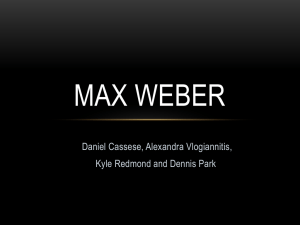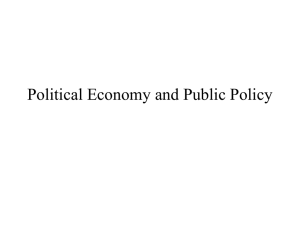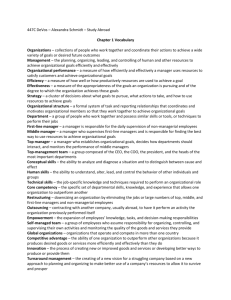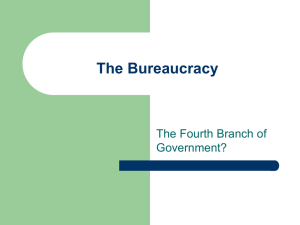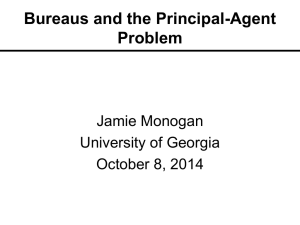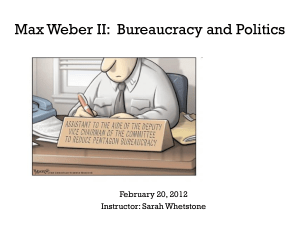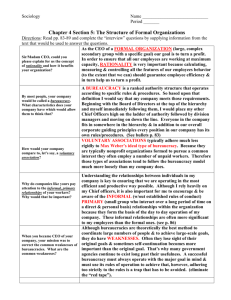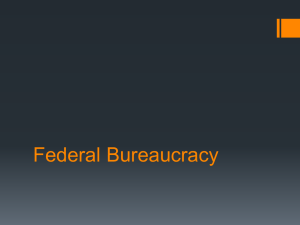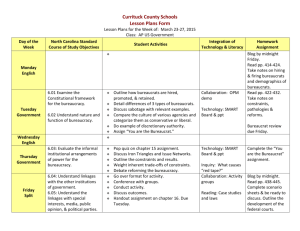Criticism for Max Weber`s Bureaucracy
advertisement
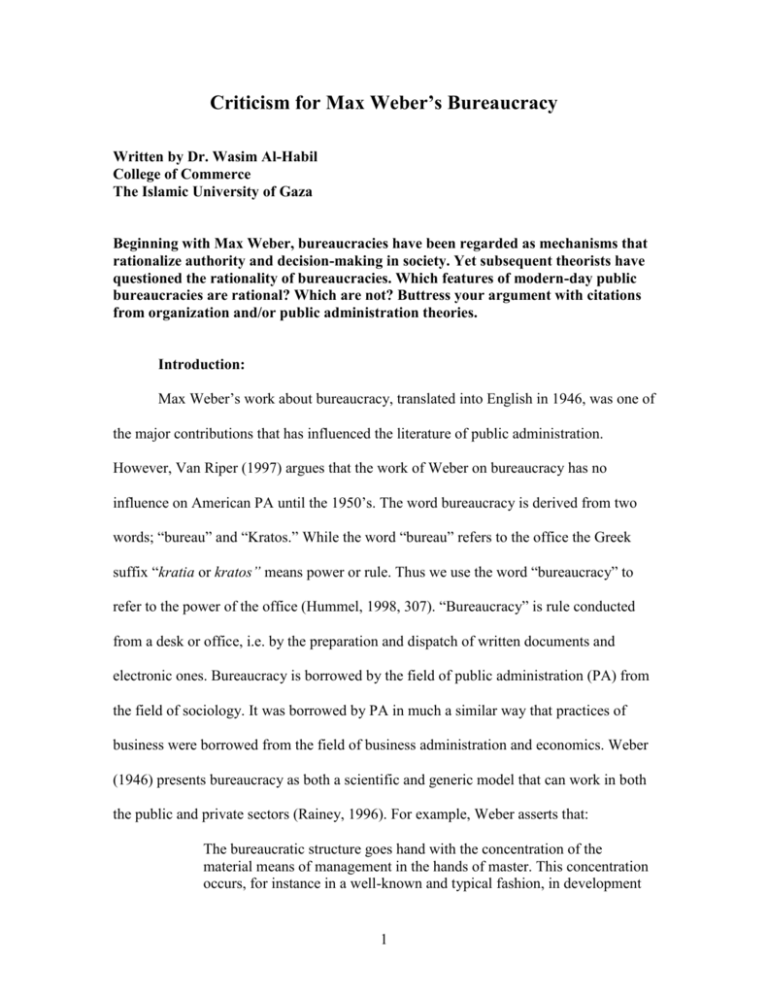
Criticism for Max Weber’s Bureaucracy Written by Dr. Wasim Al-Habil College of Commerce The Islamic University of Gaza Beginning with Max Weber, bureaucracies have been regarded as mechanisms that rationalize authority and decision-making in society. Yet subsequent theorists have questioned the rationality of bureaucracies. Which features of modern-day public bureaucracies are rational? Which are not? Buttress your argument with citations from organization and/or public administration theories. Introduction: Max Weber’s work about bureaucracy, translated into English in 1946, was one of the major contributions that has influenced the literature of public administration. However, Van Riper (1997) argues that the work of Weber on bureaucracy has no influence on American PA until the 1950’s. The word bureaucracy is derived from two words; “bureau” and “Kratos.” While the word “bureau” refers to the office the Greek suffix “kratia or kratos” means power or rule. Thus we use the word “bureaucracy” to refer to the power of the office (Hummel, 1998, 307). “Bureaucracy” is rule conducted from a desk or office, i.e. by the preparation and dispatch of written documents and electronic ones. Bureaucracy is borrowed by the field of public administration (PA) from the field of sociology. It was borrowed by PA in much a similar way that practices of business were borrowed from the field of business administration and economics. Weber (1946) presents bureaucracy as both a scientific and generic model that can work in both the public and private sectors (Rainey, 1996). For example, Weber asserts that: The bureaucratic structure goes hand with the concentration of the material means of management in the hands of master. This concentration occurs, for instance in a well-known and typical fashion, in development 1 of big capitalist enterprise, which finds their essential characteristics in this process. A corresponding process occurs in public organization (1946, 221). This belief in science was evident in Max Weber’s rational-legal authority, which became the defining feature of organizational structures, especially government bureaucracies, to this day. It steered organizational setups to rational based considerations, which are in line with the science of administration idea. In other words, Weber’s bureaucracy consists of the traditional way of thinking in public administration that relied on the same “ingredients” to reform public administration based on the science of administration (Thompson, 2005). This essay explores the nature of Weber’s bureaucracy and its influence on the PA discourse. It explains the reaction to Weber’s concept of bureaucracy and its combustion with capitalist and democratic values. In addition, the essay reflects the rational and irrational areas that can be traced in the literature of public organizations and public administration theories. It concludes by presenting an objective view of bureaucracy and its implementing implications in a democratic society like the United States. Rationality of Weber’s Bureaucracy: Weber defines bureaucracy as “the means of carrying community action over into rationally ordered social action… an instrument for socializing relations of power, bureaucracy has been and is a power instrument of the first order.” Some scholars (Friedrich, 1940; Finer, 1941; Simon, 1947; Shafritz and Hyde,1997; and Marshall in Ventriss, 2000) argue that public administration is a field of control; control of public administrators, control of people, control of inputs, and control of outputs. All these kinds 2 of controls seek to achieve one main goal which is to meet the people’s needs and expectations in an efficient way. According to Weber (1946), bureaucracy “is, from a purely technical point of view, capable of attaining the highest degree of efficiency and is in this sense formally that most rational known means of carrying out imperative control over human beings” (337). Weber argues that human civilization evolved from primitive and mystical to the rational and complex stages and relationships. Weber believes that societies move from the primitive stage to theoretical and technical ones. According to Weber, the evolution of societies is facilitated by three types of authority that he identifies as traditional, charismatic and legal-rational authority (Fry, 1989). It is the legal-rational type of authority that constitutes the basis of Weber’s concept of bureaucracy and the foundation of modern civilization as it is premised on “a belief in the legitimacy of the pattern of normative rules and the rights of those elevated to authority under such rules to issue commands” (Stillman, 2000, 51). Since Weber argues that bureaucracy grows because of society’s needs of provision of education, health, social services, collecting taxes, and others, and therefore work has to be divided and specialized to achieve the things desired by the society. In this vein, Stillman (2000) quotes Weber stating that “[t]he proper soil for bureaucratization of administration has always been the development of administrative tasks” (Stillman, 2000, 52). Key features of the ideal type of bureaucracy that Weber presents are division of labor, hierarchal order, written documents, well-trained staff and experts, full working capacity of the officials, and application of impersonal rules (Hummel, 1998, 307). However, these ingredients of bureaucracy may not, always, help organizations to reach 3 its ideal work or the most efficient performance. Michel Crozier (1964) argues that some of the bureaucratic characteristics including the impersonal rules, hierarchy, and centralization of decision-making might lead to the inability of the organization to correct or change its behavior by learning from its previous mistakes while serving the society. In fact, work within bureaucracy has to be divided rationally into units that can be undertaken by individuals or groups of individuals in a diligent manner. The hierarchical order is necessary for separating superiors from subordinates whereas impersonal rules are meant to ensure that bureaucrats are confined to prescribed patterns of conduct or performance imposed by legal rules. The rules are meant to facilitate a systematic control of subordinates by their superiors, “thus limiting the opportunities for arbitrariness and personal favoritism” (Stillman, 2000, 52). The operations of the bureaucracy “exclude irrational feelings and sentiments in favor of the detached, professional expert” (Fry, 1998, 33). Therefore, one may deduce from the foregoing that Weber believes that organizational goals can be attained if there is a science of administration which separates facts from values. Moreover, Weber believes that bureaucracy is the most rational and efficient organizational form devised by man. Weber’s bureaucracy “is rational in that it involves control based on knowledge, it has clearly defined spheres of competence, it operates according to intellectually analyzable rules, and it has calculability in its operations” (Fry, 1998, 32). In the same vein, Weber’s “[b]ureaucracy is efficient because of its precision, speed, consistency, availability of records, continuity, possibility of secrecy, unity, rigorous coordination, and minimization of interpersonal friction, personal costs, and material costs” (Fry, 1998, 32). 4 Domination is what Weber’s concept of bureaucracy is all about according to Brian R. Fry (1998) in Mastering Public Administration. It is a domination that “is exerted through administration” and “that legal domination requires bureaucracy for its exercise” (Fry, 1998, 15). Bureaucracy, states Fry, is Weber’s tool to express the most efficient and rational form of organization. By its essence, bureaucracy involves the element of control based upon the acquisition of specific types of knowledge. It is the efficient manner in which bureaucracy controls such knowledge that is its hallmark. Weber states about efficiency and bureaucracy that: Experience tends universally to sow that the purely bureaucratic type of administrative organization that is, the monocratic variety of bureaucracy is, from a purely technical point of view, capable of attaining the highest degree efficiency and is in this sense formally the most rational known means of carrying out imperative control over human beings. It is superior to any other form of precision, in stability, in the stringency of its discipline, and its reliability… it is the scope of its operations, and is formally capable of application to all kinds of administrative tasks (Weber, 1947, 337) Rational decision-making is the underlying root to the success of bureaucracy. The ideal-type of bureaucracy, according to Weber, possesses rationally discussible grounds for every administrative act. Further, it dispenses equality in concept and application as well as establishing relationships based upon a sense of permanence. According to Weber, bureaucratic organizations operate “sine ira ac studio, meaning without a sense of bias of favor, relying solely on a professional decision-maker” (Rheinstein, 1954, 190-2). With such an emphasis on professionalism, there is a sense of a guarantee that rational objectivity is the order of the day rather than the personal choices of an arbitrary authority according to Weber. 5 We can critically assess bureaucracies as organizations with similar elements to the ones described by Michel Foucault (1975) in this book, Discipline and Punish: The Birth of the Prison. Are not the employees of public organizations taught certain methods and norms? Do not they follow specific rules, procedures and ways of performing their tasks? We see structures of societal institutions that remind us of the Panopticon; workers can see and can be seen. They are constantly supervised, analyzed, tested, and reprimanded for not following the norms. People sense that bureaucracy gets involved in every domain in their life and imposes its rational restrictions and sometimes the irrational ones, which are discussed in the next part of this essay. Bureaucracy, Capitalism, & Democracy: Weber generally implies that bureaucracy exists everywhere in a capitalistic society. Weber’s conceptualizations of capitalism and bureaucracy are “mutually supportive structures” (Fry, 1998, 33). Capitalism and bureaucracy require the same impersonal type of communication, one based on transactions that require legal and ethical behavior in order to perform successfully. On the other hand, bureaucracy and democracy have a different type of relationship. It is that relationship which helps form the core of the intellectual response by the field of public administration to the integration of many Weber’s organization theory tenets. It is a relationship that is built upon influential statements by Weber and future analyses of his efforts on the subject by scholars in the realm of PA. Bureaucracy is the means for achieving rationally ordered social action. The question for public administrators is what happens if bureaucracy exceeds its bounds. First, let me offer Weber’s response to that question, which could be found in his thoughts on democracy. 6 Specifically, democracy of a special type is one where leaders are chosen to lead. On democracy, Weber writes: In a democracy people choose a leader in whom they trust. Then the chosen leader says, “Now shut up and obey me.” People and party are no longer free to interfere in his business … Later the people can sit in judgment. If the leader has made a mistake – to the gallows with him! (Gerth & Mills, 1946, 6) Political leadership in a democratic framework is necessary for supremacy of the politics over the bureaucracy. This central issue is a prime concern for Weber as well as for the scholars of PA. “Passive democratization” is a process by which Weber describes that the bureaucratic elements control its democratic participants by controlling task completion. When there are too few control outcomes, there will be a danger of elite status or control groups, which becomes difficult to dislodge. Victor Thompson (1961) explains that bureaucrats sometimes adopt behavior patterns to dominate control over people by using their authority. The disconnection between professionals and citizens has been presented succinctly by Alexander and Richmond (2003) when they talked about the rigidity of rules and professionalism by stating that: In the context of governance by the elite in that it entails rule by the experts, the philosopher kings. As a result, governance by experts limits democratic process even further because professionals are inclined to determine right action through their professional training and science – which means they may be inclined to deny input or the validity of input from citizenry/people who may have a personal stake. The ethical dilemma that results is denial of the validity of people’s lived experience and how it can inform decisions that affect them (4). On the governance level and under the umbrella of rigorous scientific, rational view, why does bureaucracy conflict with democracy? Administration (bureaucracy) is about specifics rules, procedures, and getting things done while democracy is about 7 expression of will, participation, persuasion, and considering the voices of each citizen. But to come up with the democratic administration is not an easy mission because bureaucracy itself is the tool which is applied in the administration to get the work done. Bureaucracy itself is not democratic because it is based on hierarchy. Irrationalities/Limitations of Bureaucracy: Robert Merton (1952) criticizes Weber’s bureaucracy by observing that the bureaucratic features, which Weber believes in enhancing rationality and efficiency, might actually be associated with irrationality and inefficiency. Merton concludes that bureaucracy contains the seeds of its own destruction. This part discusses the bureaucratic model of Max Weber from a critical point of view. It focuses on four main irrational limitations that bureaucracy has in terms of its ideal type, its negligence of informal organization, and its dehumanization as well as its tense relationship with democracy. In particular, Weber’s bureaucracy does not consider the important role of the informal relationships that exist in any human organizations. In addition, many in public administration argue that the reality of bureaucratic discretion is a threat to democratic norms and practices that govern and rule the American community. Regarding the first limitation and through examining Weber’s bureaucracy carefully, Weber presents to us an idealistic and platonic model of bureaucracy that can govern and run the public system in any place and at any time. Weber (1946) uses expressions like: “fully developed,” “the pure type,” “most highly developed” or “purely objective considerations” which indicate that his model of bureaucracy is perfect and complete and it always functions effectively and efficiently. Having problems in the public performance and its inability to meet the whole citizens’ social needs and political 8 rights in any country negates the claim that the bureaucratic model is an idealistic and platonic system. Bureaucracy of Weber has not demonstrated that it is “fully developed” structure under the regular conditions in reality. Peter Blau and Marshall Meyer (1987) argue that “since perfect bureaucratization is never fully realized, no existing organization precisely fits the ‘ideal type’… [which] does not provide understanding of concrete bureaucratic structure” (25). In other words, it does not seem right for organizations to follow an ideal guide which may never be reached or may not work efficiently when it is applied. Even though if one argues that the ideal bureaucracy is only a conceptual guide for organizations to follow, it should be clear that this guide might be a misleading one because organization possesses “patterns of activities and interactions that reveal how social conduct is organized” (Blau and Meyer, 1987, 26). Blau and Meyer (1987) assert that “empirical studies have shown that this approach is misleading” (27). However, this essay emphasizes that the word “ideal” did not imply or mean “the best” or “what we should strive for.” Weber meant it as “defining characteristics” – that is, when we use the word this is what is meant. It is essentially a conceptual model of bureaucracy rather than something we thought that we should strive for. The second limitation that one can argue in regard to the bureaucratic model of Weber is the unawareness of the role of informal organization in affecting the efficiency of organization’s performance. Weber focuses mainly on the formal elements of bureaucracy such as specialization, rules, hierarchy, and others. On the other hand, the informal elements including human relationships, leadership, communication networks, motivation, and others were not given the attention that they deserve in the functions of 9 the public and private organizations as well. The existence and importance of informal organization, which is defined as “the aggregate of the personal contacts and interactions and the associated grouping of people” (Barnard, 1966, 115), is highly accepted in the field of management. Barnard (1966) affirms that “informal organizations are necessary to the operation of formal organizations as a mean of communication, of cohesion, and of protecting the integrity of the individuals” (123). This importance of informal organizations is not seen in the bureaucratic model of Weber which focuses on formal structures only. Even though he talks about some social, political, or behavioral conditions of individuals in organization, his perspective emerges mainly from the framework of the formal organization. Thirdly, Ralph P. Hummel (2007) in his classic book, The Bureaucratic Experience (5th edition), argues that bureaucracy is getting worse in spite of all efforts exerted by the theorists of quality management, corporate reengineering, and the new public management because it is still “business as usual” for bureaucracies. He explains that bureaucrat becomes only a mechanistic technician who is detached from her/his humanity, emotions, society, and even her/his individual thinking describing it as “the bomb that threatens humanity.” He adds that bureaucracy replaces human identity, character, and autonomous will by the organization identity (Bodley, 2002, 75). Moreover, bureaucracy forces human to substitute her/his sense of right and wrong while performing her/his daily tasks by decisions, rules, and instructions imposed by higher supervisors who might be away from the real social context and its necessities. Hummel states that bureaucracy deals with human beings as cases rather than human beings who are in need for social and economic services stating that “[w]hat is a case? A case is 10 never a real person” (28). If the case meets the rules and laws of bureaucracy the case can be served. However, if the case does not meet the eligibility the case can be neglected even if it is worthy to be served from a human discretional point of view. Hummel announces that there is a conflict between society and bureaucracy and “all attempts to humanize relationships between a bureaucracy and society must therefore considered as suicidal or window-dressing when they come from within bureaucracy itself, and as declaration of war when they originate in society” (41). In other words, bureaucracy is blind, deaf, and dumb. The Application of Bureaucracy in a Democratic Society: From Waldo’s (1948) insight about the impossibility of really separating politics and administration, scholars of PA can infer that there is tension in the literature between bureaucracy and democracy. Regarding the fourth limitation, many American scholars have expressed their concerns that the reality of bureaucratic discretion is a threat to democratic norms and practices. For example, we do not know how bureaucracy functions in light of what both Blau and Meyer argue that “to protect ourselves against the threat of bureaucratic domination while continuing to take advantage of the efficiencies of bureaucracy, we must first learn fully to understand how bureaucracies function” (Blau and Meyer quoted in Lane, 1999, 8). Blau and Meyer explain that Weber confessed that established bureaucracies are, at best, ambivalent toward democracy. “On the one hand, bureaucratization tends to accompany mass democracy. On the other hand, bureaucracies tend not to be responsive to public opinion” (Blau and Meyer quoted in Lane, 1999, 12). People ask all the times whether public bureaucracies can be controlled completely or not, according to Lane 11 (1999). James Wilson (1989) clarifies that there are three ways in which political power may be gathered undesirably into bureaucratic hands: by the growth of an administrative apparatus so large as to be immune from popular control, by placing power over a governmental bureaucracy of any size in private rather than public hands, or by vesting discretionary authority in the hands of public agency so that the exercise of that power is not responsive to the public good (Lane, 1999, 40). Meier and O’Toole (2006) find that bureaucrats are powerful and can alter political programs to reflect their own values – they are strategic agents. James Q. Wilson (1989) argues that American bureaucracy is laden with rules, “that is a sure sign that the bureaucracy is aloof from the people, distant from their concerns and preoccupied with the power and privileges of the bureaucrats – an elaborate, grinding machine that can crush the spirit of any who dare oppose it” (Wilson, 1989, quoted in Stillman, 2000, 484). Due to the irreconcilable differences between administrative traditions and the impossibility of managing a modern society without bureaucracy, it is not surprising that scholars have had difficulty explaining the relationship between bureaucracy and representative government. The problems bureaucrats must deal with do not always fit into the hierarchy and authority based structures. Although McSwite (1997) lament the reluctance of people within the field of public administration to resolve the question of how bureaucracy fits into democracy, they are of the view that “keeping the question alive is essential to the identity that it wishes to maintain for the republic administrator – the power-wielding Man of Reason” (231). In other words, the more time we spend discussing the role of bureaucracy in the organizational development, the more the professionals or experts (bureaucrats) who 12 dominate the decision-making process will continue to consolidate their position within the society. American liberal thought is a major source of frustration to those who seek a theoretical base that integrates democratic and bureaucratic theory. This tension generates a conflict between democratic and bureaucratic perspectives on governance and precludes an effective integration of the two. What seems clear is that the conflict between bureaucracy and democracy is steeped in “primordial controversy” (Rohr, 1986, 59-73). A discourse on the tensions between bureaucracy and democracy could provide guidance to administrators through a better understanding of the conceptual barriers to the development of a theory of democratic administration. The tension between bureaucracy and democracy leads the discussion to the issues of legitimacy of bureaucracy, power, discretion, and judgment in the field of public administration. Stivers (2001) states that This tension [between democratic governance and bureaucratic effectiveness] has made important topics of debate…Beneath these questions is the even more fundamental issue…how to make the power exercised by career bureaucrats consistent with the democratic government. It is assumed that modern government needs the expert and efficient action that bureaucracy makes possible. But a basic tenet of democracy, enshrined in the U.S. Constitution, is that public power ultimately comes from the people. How, then, does the bureaucracy make itself answerable to the people? (Stivers, 2001:159). Bureaucracy is no longer considered a closed system since citizens can participate in the decision-making process through advisory boards, neighborhood council and others forms. In this vein, Wilson (1989) contends that the system has become irrational and inefficient. He bemoans this situation by stating that “this popular involvement would be taken as evidence that the administrative system is 13 no system at al, but a bungling, jerry-built contraption wallowing in efficiency and shot through with corruption and favoritism” (Wilson quoted in Stillman, 2000, 484). As a result of adherence to rules and openness to the public, Wilson observed that “public bureaucracy in this country is neither as rational nor predictable as Weber hoped nor as crushing and mechanistic as he feared. It is rule-bound without being corrupt” (Wilson quoted in Stillman, 2000, 484). He goes further by arguing that the governments of the United States were not designed to be efficient or powerful, but to be tolerable and malleable. Objective View on Bureaucracy: Trying to be objective as much as possible, neither democracy nor society will have chance to survive without bureaucracy because the latter (democracy) will not be able to carry out the programmatic promises of its elected leaders (Goodsell, 1994, 152). Waldo held that since democracy has long been accepted as the most appropriate form of government in America, it has served the “higher law.” The central issue of our time according to Waldo is that the potential conflict of bureaucracy and democracy are intimately joined. Bureaucracy to Waldo meant large-scale, formal, complex, task specialized, and goal oriented organizations. Democracy is characterized by values and ethics and it is not totally incompatible with bureaucracy. The bureaucracy, on one hand, supports democratic values and, on the other hand, has some conflicting characteristics such as hierarchy and discipline and supervision which conflict with equality and liberty. Waldo contends what we must accept that both bureaucracy and democracy are desirable and necessary and we should seek for an optimum mix between the two (Fry, 1989, 236). 14 Many researchers examine the assumption that democracy and bureaucracy are incompatible. However, they conclude that bureaucracies respond to local electoral politics in way that reinforces and improves democratic controls (Scholz & Headrick, 1991, 829-850). The traditional view is that bureaucrats who are members of professions are especially adept at evading external controls because of their special expertise and ties to professional groups outside government. However, bureaucratic professionals often have no monopoly of skills or information, hold no homogenous values, and are subject to numerous checks. On the positive side, professionalism promotes bureaucratic responsibility and accountability through professional norms, as well as democratic decision rules, and provides “a Rosetta Stone for deciphering and responding to various elements of public interest” (Kearney & Sinha, 1988, 571-579). Moreover, we have to remember that some scholars in the field, including (Rohr, 1985), argue that bureaucrats have the legitimacy to rule based on the following rational justifications: 1. They are competent, well- educated and trained and they do know things. 2. They have long-term tenure which enables them to be experts in the details pf the public issues in contrast to the politicians who have a fixed period. 3. Bureaucrats are from people and they enjoy the values and they have the good will to serve people and society. So they should be given the chance to rule and people should not worry. Conclusion: It has to be acknowledged that even though Weber believes rationality and efficiency can be attained through bureaucracy, he was mindful of its shortcomings as evidenced by the fact that he also associated it with “an oppressive routine adverse to 15 personal freedom” (Fry, 1998, 33). He realizes that bureaucracy limits individual freedom and makes it difficult if not impossible for individuals to understand their activities in relation to the organization as a whole. Most importantly, bureaucracy favors what Weber called the “crippled personality of the specialties” (Fry, 1998, 33). Due to the irreconcilable differences between the administrative traditions that were presented by the founding fathers and the impossibility of managing a modern society without bureaucracy, it is not surprising that scholars within the field of public administration have so far failed to come up with an adequate theoretical base to explain the relationship between bureaucracy and representative government (Warner, 2001). The changes that have taken place within the American society make it clear that the problems administrators have to contend with do not easily fit the existing structure of hierarchy and authority based structure. Hence, the need to restructure or readjust the bureaucracy to adapt to new and complex problems becomes apparent. Unfortunately, there is no consensus regarding how the restructuring can be done and this issue will remain one of the hot debates in the field of PA for the coming decades. 16 References: Alexander, Jennifer and Richmond, Sam. (2007). The Cider House Rules. American Review of Public Administration, 37(1) 51-64. Barnard, Chester I. (1966). The Functions of Executive. Cambridge, Massachusetts: Harvard University Press. Blau, Peter M. and Meyer, Marshall W. (1987). Bureaucracy in Modern Society. New York, NY: Random House. Bodley, John H. (2002). The Power of Scale: A Global History Approach. M.E. Sharpe Crozier, Michel. (1964). The Bureaucratic Phenomenon. Chicago: University of Chicago Press. Finer, Herman. (1941). Administrative responsibility in democratic government. Public Administration Review, Vol. 1: 335-350 Foucault, Michel. (1975). Discipline and Punish: the Birth of the Prison. New York: Random House. Friedrich, C. (1940). Public policy and the nature of administrative responsibility. In C. J. Friedrich (Ed.), Public Policy: 3-24. Cambridge: Harvard University Press. Fry, Brian. (1989). Mastering Public Administration. Chatham, NJ: Chatham House Publishers, Inc. Gerth, H, and G. Wright Mills. (1946). From Max Weber: Essays in Sociology. New York: Oxford University Press. Goodsell, Charles. (1994). The Case For Bureaucracy. Chatham House Publishers, Inc., New Jersey, 152-159 Kearney, Richard & Sinha, Chandan. (1988). Professionalism and Bureaucratic Responsiveness: Conflict or Compatibility? Public Administration Review, January-February 11988, 571-579 Hummel, R. (2007). The Bureaucratic Experience: The Post-modern Challenge. The 5th edition. Library of Congress Cataloging-in-Publication Data Hummel, R. (1998). Bureaucracy. The International Encyclopedia of Public Policy and Administration: 307 Lane, Frederick. (1999). Current Issues in Public Administration. Bedford St. Martin’s, Sixth Edition, Boston: 103 17 McSwite, O. C. (1997). Legitimacy in Public Administration, a Discourse Analysis. Sage Publications, Inc. Merton, Robert. (1952). Bureaucratic Structure and Personality in Reader in Bureaucracy. New York: Free Press Rhienstein, Max. (1954). Max Weber on Law in Economy and Society. New York: Simon and Shuster Rohr, J. A. (1985). Professionalism, Legitimacy and the Constitution. Public Administration Quarterly, 8(4), 401-418. Rohr, John A. (1986). To Run a Constitution, 59-73. (Seminar in Public Administration, Course Packet, Dr. Kenneth Hanson). Scholz, John & Hedrick, Barbara; Twombly, Jim. (1991). Street-Level Political Controls over Federal Bureaucracy. American Political Science Review:.529-850 Shafritz J. & Hyde A.C. (1997) Classics of Public Administration. Orlando: Harcourt Brace College Publishers. Simon H. (1946). Administrative Behavior. New York, NY: Free Press. Thompson, Victor. (1961). Modern Organization. New York: Alfred A. Knopf. Ventriss, C. (2000). New Public Management: An Examination of its influence On contemporary Public Affairs and its Impact in Shaping the Intellectual Agenda of the Field. Administrative Theory & Praxis. (22) 3:500-518. Waldo, D. (1948). The Administrative State. New York: Holmes and Meier Publishing. Weber, Max (1946). Bureaucracy. Oxford Press Wilson, J. Q. (1989). Bureaucracy: What Government Agencies Do and Why They Do It. Basic Books 18
